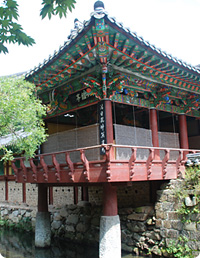PACKAGE
Mini Circle (A) 10 days
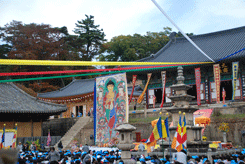
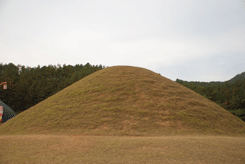
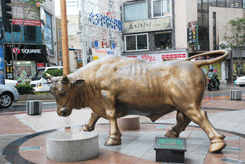
Tour Highlights
- Gyeongbokgung Palace
- National Folk Museum of Korea
- Insadong
- Namdaemun Market
- Unification Observatory
- Kim Ilsung Villa
- Geojin Fishing Village
- Seoraksan National Park
- North Korean Submarine
- Jeongdongjin
- Hwanseongul Cave
- Dosan Seowon
- Hahoemaeul Village
- Ganggu Fishing Port
- Yandongmaeul Village
- Seokguram
- Bulguksa
- Gyeongju National Museum
- Donggung Palace and Wolji Pond
- Cheomseongdae
- Tumuli Park
- Bunhwangsa
- Goryeong Tumuli Museum
- Daegaya Museum
- Haeinsa
- Beopjusa
- Hwaseong Fortress
Click on the days to access the program quick
| Days | Visits and Activities | Distance |
| Day 1 | Arrive Seoul | 60km |
| Day 2 | Seoul | |
| Day 3 | Seoul - Goseong - Seorkaksan | 310km |
| Day 4 | Seoraksan | |
| Day 5 | Seoraksan - Jeongdongjin - Dosan - Andong | 290km |
| Day 6 | Andong - Yeongdeok - Yangdong - Gyeongju | 230km |
| Day 7 | Gyeongju | |
| Day 8 | Gyeongju - Goryeong - Gayasan - Songnisan | 290km |
| Day 9 | Songnisan - Suwon - Seoul | 200km |
| Day 10 | Departure | 60km |
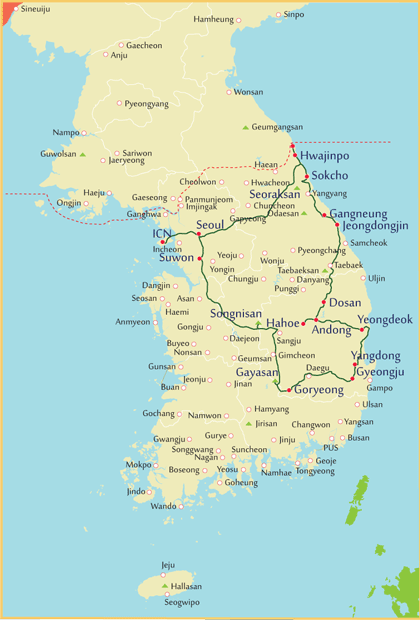 Day 1 Arrive Seoul (- - -)
Day 1 Arrive Seoul (- - -)
60km
Touching down at Incheon International Airport places you in the heart of Korea. After you clear Passport and Customs control, you will be welcomed by the tour guide and then transferred to your hotel.
Day 2 Seoul (B)
Your exploration this morning begins with a driving tour of Seoul, featuring sites such as Seoul Plaza, City Hall, Cheonggye Square and pedestrian-friendly Gwanghwamun Plaza that is hemmed in on both sides by rushing traffic and office buildings. The plaza is lined on each side with 365m long streamlets, two centimeters deep and one meter across, the stone bed of the plaza's east side waterway engraved with important events in chronological order from 1392 to 2008.
Standing high on a stone pillar is a statue of Yi Sunsin who had engaged in twenty-three naval battles and emerged victorious in all of them during the Hideyoshi invasion (1592-1598). King Sejong who propagated the Korean alphabet in the 15th century is also honored with prominent statue. On August 16, 2014, Pope Francis celebrated Mass in this plaza to beatify 124 Korean martyrs. Near the southwest corner of the plaza is Korea's Kilometer Zero, marking the distances to 64 cities around the world, including Seoul's antipode, Montevideo, Uruguay, 19,606km.
Step back in time to when life was gracefully slow and discover Gyeongbokgung Palace, a particularly charming spot that represents a colorful and turbulent side of the capital's 500-year history. Depending on timing, you may witness the Royal Guard Changing Ceremony featuring parade, password verification, duty shift and patrolling the gate. Accompanied by a court band with its colorful costumes and royal flags, the ceremony is performed daily basis at 10:00 and 14:00 except Tuesdays, although it is cancelled in case of rain or extremely hot or cold weather.
Up from the gates is a spacious stone-paved courtyard that is fully enclosed by wooden cloisters, and at the center of which runs three footpaths through two rows of rank stones, indicating the positions of the officials with the highest rank being closer to the hall.
Standing majestically on top of a two-tiered stone platform that is lined with detailed balustrades is Geunjeongjeon Hall, where the king formally granted audiences to his officials, gave declarations of national importance, presided over large official functions, and greeted foreign envoys and ambassadors. Check out the royal throne and a large painting, depicting sun, moon, five peaks, streams and pine trees, which was the crucial signifier of the king. And up in the center of the ceiling, the bright golden dragons in bold relief indicate the presence of the king.
At the back of the throne hall is a group of court offices. Displayed in front of the King's official quarters is sundial, conceived in order to catch the shadow of the sun, which tells time and 24 periods of seasonal change from the winter solstice to the summer solstice.
Sitting on the island in the rectangular lake is Gyeonghoeru. Supported by 48 square and cylindrical massive stone pillars representing the idea of Yin and Yang, this magnificent pavilion was used for many purposes ranging from receptions to national examinations.
Gangnyeongjeon is the king's sleeping and living quarters while Gyotaejeon is the queen's domain containing a number of halls. The noted feature of these main buildings is an absence of a top roof ridge.
Amisan Garden, landscaped with four hexagonal chimneys in orange bricks, is seldom noticed by the hurried visitors. Jagyeongjeon is the queen dowager's residence. Although less colorful, it is worth noting the wall, adorned with floral designs and the chimneys with ten longevity symbols.
Hyangwonjeong features a small pond with a manmade islet that supports a beautiful two-story pavilion. Behind this serene garden is Geoncheonggung, where the king and queen could relax in peace and quiet. It was here that the first electric lights in the country were installed in 1887 after 8 years of Thomas Edison's invention and a tragic chapter in Korea's history was recorded when empress Myeongseong was assassinated by the sword-bearing Japanese assassins in the early morning of 8 October 1895, allegedly under orders from Miura Goro.
Your visit to the National Folk Museum of Korea will familiarize you with wealthy culture of this friendly and picturesque nation. It is an excellent facility to illustrate the history of traditional life of the Korean people from the prehistoric age to the Joseon dynasty. The permanent exhibition features life and work, costumes and ornaments, handicrafts and technology, educations, living quarters, dietary life, oriental medicine, performing arts and games, beliefs and rituals, and
socio cultural life.
Insadong, at one time the center of traditional Korean art and antiques, features a mixture of historical and modern atmosphere representing the cultural glimpse of the nation. Clustered along the main street and alleys are lined with street vendors, wooden tea houses, restaurants and numerous galleries and shops dealing in antiques, oriental art supplies, and modern Korean art of all types and styles. Soak in the paintings, upscale artworks, antiques and potteries while you can. Get lucky and you just might meet the artist themselves. It can be plenty of fun walking on the main street, but you venture into the hidden alleys that do spring some unexpected surprises. While here, you may want to buy some souvenirs or simply wander and browse at leisure admiring cultural ambience.
Drive past Cheonggyecheon Stream. After the Korean War (1950-1953), more people migrated into Seoul to make their living and settled down along the stream in shabby makeshift houses. The accompanying trash and waste, and deteriorating conditions resulted in an eyesore for the city. The stream was covered with layers of concrete in the mid 1950s and roadway until the massive urban renewal project freed it in 2005. Today, a 5.8km creek tumbles gently through downtown Seoul, providing a much needed source of peace and relaxation for the citizens of this fast-paced city. You may have a chance to view the sculpture standing tall at the head of the stream on a small plaza. Created by Dutch artist Coosje Van Bruggen and Swedish artist Claes Oldenburg, a shell rising upward like pagoda symbolizes new life.
You will tour the centuries-old Namdaemun Market brimming with well over 11,000 shops selling anything you can imagine. One of the most colorful aspects of the market is an endless sprawl of street-vendor stalls that setup in the alleys and walkways between the buildings. The market is seriously crowded, so be prepared to get bumped around. A fantastic place to haggle over the price to get the best deal on something you want or simply admire the vibrancy of this massive market.
At the western entrance of the market in the middle of a traffic circle stands Sungnyemun. It is a formidable and iconic construct that served as the southern gate of the wall that surrounded Seoul during the period of the Joseon Dynasty.
Day 3 Seoul - Goseong - Seorkaksan (B) 290km
As you make your way to the east coast, enjoy the picturesque countryside, tranquil nature and beautiful landscape. At the northern tip of the east coast sits Unification Observatory. With the entry permit and sign to place in the vehicle window ready, continue towards the north, driving past lots of tank traps comprising large lumps of concrete set on either side of the road, all a strange and eerie reminder of the tensions that exist between the two Koreas and the stark reality of the divided country. While there, you will get a glimpse of the much talked about border dividing the two Koreas and see the road and train track stretched side by side ahead across the North Korea.
Stop at DMZ museum (Closed on Mondays) offering very surreal experience of a lifetime. In the hopes of bringing peace to the country from the painful past, the museum presents the South Korean side of the conflict with the North, underscoring the historical significance of the DMZ and embracing everything about the latest efforts made to transform the DMZ from a place of political scars to a symbol of peace and ecology.
Enjoy a short tour of Socho that has so much more to offer than just mountains. In downtown, there is a colorful market selling fishes, fruits, vegetables, grains and daily necessities, and a little further down is a North Korean refugee village that can be accessible by a hand-pulled boat. At Daepohang, you will see a wide variety of fresh seafood harvested from the nearby sea and a number of small restaurants serving sliced raw fish. You will find something to enjoy, from simply feeling the ambiance of this small fishing port to taking picture.
Seoraksan national park is a place that you can definitely find lots of outdoor activities to make it worthwhile for an extended stay. The dense forests bordering crystal clear streams which tumble over cataracts and drop from precipices to form white waterfalls, as well as awesome saw tooth cliffs spiraling into the blue skies, and scenic valleys altogether make this park and surrounding area some of the most beautiful sceneries on the Korean peninsula, and give this area an unparalleled popularity around the year.
Day 4 Seoraksan (B)
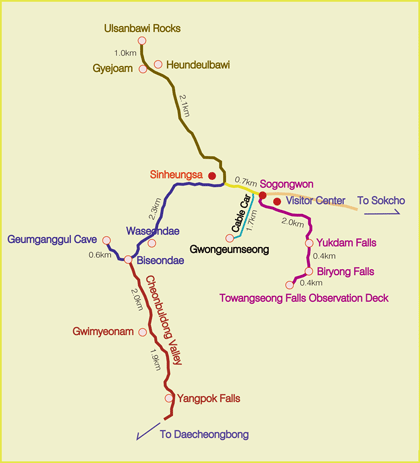 The word of the day is hiking of varying lengths and difficulty. All route types are out and back. Today, you will form your own independent tour to explore Seoraksan national park that has many different trails, and you are free to pick and choose which ones you want to do.
The word of the day is hiking of varying lengths and difficulty. All route types are out and back. Today, you will form your own independent tour to explore Seoraksan national park that has many different trails, and you are free to pick and choose which ones you want to do.
Only a small walk from the park entrance (Sogongwon), you will marvel at a large bronze statue, Unification Buddha, symbolizing Korean people's hope for reunification of the country. A little further on is Sinheungsa temple which claims to be the Korea's oldest Zen temple. Left trail in the direction of the temple is a trailhead of Cheonbuldong valley, the most impressive valley in the park, leading finally to the Daecheongbong peak of Seoraksan (1,708m), while right trail is up to Ulsan Bawi Rocks.
Among the most recommendable trails from Sogongwon are as follow and the given times below are based on round trip in a bit relaxed pace.


Cheonbuldong valley Trail
One hears many legends of the heavenly nymphs who come down to play at Biseondae while taking a bathe in the placid pools of the valleys that are hidden from the human eyes. Near Biseondae rises Janggunbong majestically and among the crags of it is a temple alcove, Geumgang cave. You may want to head up a very steep incline for 600m from the gentle slope of the trail, and you can scale only by carefully ascending the long, steep, metal stairs bolted onto the sheer cliff face. The hike, although hard, comes with a stunning view of numerous cliffy peaks and mountain valley. From Biseondae, another 3.5km to Yangpok Falls, so spacious yet everywhere you looked you are surrounded by giant mountain peaks.

Ulsanbawi Rocks Trail
About an hour and half into the walk from the park entrance is Gyejoam hermitage. Located at the base of Ulsanbawi, and the point at which the trail takes a sharp rise upwards. In front of the hermitage on a spacious stone slab is a huge spherical rock called Heundeulbawi. This rock is soperfectly balanced that it can be shaken with some effort, but nobody gets further than waggling it. Your adventure begins by climbing a massive steep staircase that winds its way up the side of the cliff that angle up Ulsanbawi which is in a folding screen shape made up of cliffs on all sides. It is a 1.8km-long ridge of naked, gray stone peaks jutting well over 800m into the sky.

Biryong waterfall Trail
The trail is relatively easy for anyone to try and you will view Biryeong waterfalls at the trail end. About 400m further above the falls, you will be amazed at Towangseong waterfalls cascading down a 320-meter cliff.
Cable Car
There is a cable car that picks you up at the valley floor to the Gwongeumseong. The peak is surrounded by cavernous drop-off cliffs, cloaked in more towering rocky summits. Definitely, you stand in awe on the top: sweeping panoramic views of the park around you, the Pacific Ocean, and the small beachside town of Sokcho. Be careful as always as there is not much room to move about and people constantly going up and down and moving around.
Hiking Trails
1. Biryong Falls (4.8km): 2 hours - Walking on a trail and suitable for whole family
2. Biryong Falls + Towangseong Falls Observation Deck (5.6km): 3 hours 30 minutes - Serious hiking from Biryong Falls to the observation deck
3. Biseondae (6km): 3 hours - Walking on a trail and suitable for whole family
4. Biseondae + Geumgang cave (7.2km): 4 hours 30 minutes - Very strenuous hiking from Biseondae to the cave
5. Biseondae + Yangpok (13.8km): 7 hours - Walking on a trail and no use of hands
6. Heundeulbawi (5.6km): 3 hours - Walking on a trail and no use of hands.
7. Heundeulbawi + Ulsanbawi (7.6km): 5 hours 30 minutes - Very strenuous hiking from Heundeulbawi
8. Gwongeumseong Cable car (3.4km): 1 hour (roughly four minutes each up and down)
Day 5 Seoraksan - Jeongdongjin - Dosan - Andong (B) 290km
Depart Seoraksan early this morning to arrive in Andong, a stronghold of Confucianism.
Drive past the salvaged North Korean submarine that is on display together with retired Korean navy ship. The three armed guerillas infiltrated into the land on September 15, 1996, to spy on the naval installations in the area while the others were on standby in the submarine. However, it ran aground on September 18. The crew eventually abandoned any attempt to find their way back to the North and split up in several groups. But, one was soon spotted by a civilian who became suspicious and alarmed the authorities. Counterespionage operation was in progress for 49 days and of the 26 North Korean infiltrators, 1 was captured alive, 13 spies were shot, 11 were murdered by their colleagues and 1 reportedly escaped back to North Korea.
After a short break at Jeongdongjin, a tiny village located by the ocean with a quaint railway station of being the closest to the ocean anywhere in the world, explore Hwanseongul Cave. About 30 minute grueling uphill hike from the ticket office or a 6 minute on a mono rail gets you to a cave entrance of overwhelming size in the middle of the mountain. The cave itself is super massive and it would take well over one hour to explore. Be prepared for wet walkways, maneuvered up a narrow corridor with a rapidly flowing creek below it and hung off the side of the cave's walls above the creek. Many waterfalls are actively eroding the floor. Only 1.6km open to the public; yet that section alone will provide unforgettable memories. Cave tour is absolutely at your choice. You could opt out by staying outside, or simply relax.
Tour includes Dosan Seowon, a Confucian-shrine academy which was established in 1574 in memory of Yi Hwang (1501-1570) who introduced Neo-Confucianism into Korea. The facility is composed of 16 buildings most of which were built in a simple and concise style. About hundreds of Seowon were functioning by the early 1800s, but then most of them were destroyed around 1870 by the court order. Dosan Seowon is among some of the few survived academies. Although the educational function of the facility has long since ceased, but you can feel Confucian ideology and value that has deeply influenced the lives of Koreans in all aspects.
Day 6 Andong - Yeongdeok - Yangdong - Gyeongju (B) 230km
Explore UNESCO World Heritage Site, Hahoemaeul from the 15th century. It is the best preserved traditional village portraying and spanning the life of the Joseon Dynasty (1392-1910) and some 480 Korean traditional houses, both large and small, are still fully functioning. As you take a walk in the narrow alleys, enjoy the rustic and old charm of this unique village. You cannot possibly miss a 600-years old zelkova tree, the home to the village spirit. At the tree's base is where residents still make their wishes. The village is also known for traditional festival, Hahoe Mask Dance which gave common people the opportunity to mock those in authority, and in particular the Byeolsingut, a shaman ritual exorcising evil spirits, dating back to the Goryeo dynasty (918-1392).
Jebiwon Buddha is an awe-inspiring statue standing guard over the northern entrance way to Andong for nearly 1000 years. The 2.43-meter-high head of granite Meitreya Buddha rests on top of a 9.95-meter-high and 7.72-meter-wide stone outcropping engraved with the Buddha's body. It's a relief-carving of the body on a sheer boulder-side, under a 3D-carved head made from a natural stone found on top of that cliff. It is now cared-for by a small temple tucked below and behind it.
En route, stop off at Yeongdeok, a charming but quiet town safely removed from the tourist trail. Yeongdeok is highlighted with Ganggu wharf, best known as the trade center of snow crab in Korea. While here, you will get to learn how the crabs are brought into the port to the sight of thousands of them laid out on the ground. This small port is busy every morning with dozens of aquarium cars for live fish available for sale. The alley is packed with many restaurants serving snow crabs. Trying them here is a special treat and an exceptional experience.
You will explore UNESCO World Heritage Site, Yangdongmaeul, a delightful journey to the traditional clan village which embraces simple, unadorned natural beauty. There are some steep hills to climb but also easier streets. Over 150 homes as well as two shrines are in perfect harmony with the natural topography, presenting different angles where walls ascend a hill interspersed with tiled roof houses or thatched roof buildings.
Gyeongju is an ancient capital of the Silla dynasty (BC57-AD935) often dubbed as Museum without Walls. Today, you are treated to one of the ten most historically significant sites in the world with ancient temples, weathered stone pagodas, royal tombs, Buddhist bas-reliefs, and fortress ruins.
Day 7 Gyeongju (B)
With a full day to further explore the delights of UNESCO World Heritage Site, Seokguram grotto. It is the home of the serene stone Buddha of the eighth century. Inside, a white statue of a seated Buddha in a sublime state of enlightenment, is surrounded by 37 relief figures of Bodhisattvas, disciples, devas, and guardian kings. The grotto represents the magnificent harmony of religion, science and the arts of Buddhism, symbolizing the pure land in which Buddha resides.
A short ride leads you to another UNESCO World Heritage Site, Bulguksa temple, where you will witness the impressive gates, symbolic bridges leading up to the world of Buddha, graceful architectures, Three-storied Seokgatap and highly ornate Dabotap blending well into the architectural harmony.
At Gwaneumjeon hall, check out the image of the Avalokitesvara who is referred to as the Bodhisattva of Compassion and has a thousand hands, and eyes in each so as to reach out to those in need of help. You will see a gilded statue of Vairocana with the gesture of the first wisdom, Sakyamuni Buddha along with sixteen figures of Buddha's disciples sitting in deep meditation, and a gilt-bronze Amitabha Buddha who is the ruler of the Western Paradise Sukhavati. The architectural design of Bulguksa is one of constrained dignity, peace, and harmony and the temple still remains one of the most remarkable achievements of the ancient Far East.
The Gyeongju Historic Areas contain a remarkable concentration of outstanding examples of Korean Buddhist art, in the form of sculptures, reliefs, pagodas, and the remains of temples and palaces from the flowering, in particular between the 7th and 10th centuries, of this form of unique artistic expression.
Visit Gyeongju National Museum for a great insight into Silla culture and history. The first thing that you will notice is The Bell of King Seongdeok, the largest extant bell in Korea. You must certainly stand in awe before the bell from the 8th century with such artistic beauty of design. The bell is distinguished not only for its outstanding beauty but also for its long reverberating sound, the incredibly precise casting technique, in addition to the sad legend surrounding it. On entering the museum, you will marvel at the priceless archaeological and historical artifacts including splendid gold crowns, earrings, belts, ornaments, glassware, potteries, and clay figures as well as a royal barge.
Continue your historic discovery by exploring Donggung palace and Wolji pond, a pleasure garden built to commemorate the victory of Silla. A short walking tour leads you to the ruins of Banwolseong fortress, the world's oldest existing astronomical observatory, Cheomseongdae and finally Tumuli Park that encompasses 23 huge burial mounds. You can go inside Cheonmachong and see how the tombs were made and replicas of the treasures excavated in 1973.
Tour also includes seventh century Bunhwangsa. Check out a 10m-high three-storied rectangular pagoda, the main worship hall with Buddha of Medicine, and legendary well that is said to have saved the kingdom. The nearby open field was once occupied by Silla's largest temple Hwangyongsa with its 67m tall nine-storied wooden pagoda until they were destroyed during the Mongol invasion in 1238.
Day 8 Gyeongju - Goryeong - Gayasan - Songnisan (B) 290km
En route stop at Goryeong Tumuli Museum featuring a perfect replica of the Jisan-dong Tomb No. 44 itself and learn about the ancient sacrificial burial custom a funerary practice. About 40 persons were presumably entombed together. Such examples of massive human sacrifice have not been found in other ancient tombs of the era of the Three Kingdoms. Visit also includes Daegaya Museum exhibiting a huge collection of artifacts excavated in Goryeong.
Journey continues to the 9th century Haeinsa. Renounce each of 108 worldly desires of the mind as you climb 108 stairs. Within the Hall of Great Peace and Light, you will see Vairocana Buddha attended by Bodhisattvas and highly detailed and rather unusual wall paintings of the Buddha's life. And on the outside walls are a fair number of paintings portraying Buddhist stories. At the back of this hall is a group of four depositories or Janggyeong Panjeon from the 15th century. Housed within the depositories are 81,258 wood-blocks of Tripitaka Koreana, the world's oldest and a complete collection of the Buddhist sutras as well as an offering to the Buddha for national protection from the looming Mongol forces. The printing blocks are some 70cm wide, 24cm long and 2.8cm thick on the average. Each block has 23 lines of text, each with 14 characters, on each side. Each block thus has a total of 644 characters on both sides. Some 30 men carved the total of 52,382,960 characters in the clean and simple style. The characters are perfectly carved as if from the same hand. They were completed in 1251 after 16 years of work on Ganghwado and were transported here for safekeeping. The Mongol forces eventually took over the Goryeo Dynasty but the wooden blocks remain preserved today having survived other invasions, wars and fire. Even more amazing aspect is that neither birds built nests nor spiders make webs on these buildings. Check out two long depositories are designed to have natural ventilation by facing different size windows in the front and rear of the building. Tripitaka Koreana and Janggyeong Panjeon have been designated by UNESCO as a World Heritage for their artistic as well as religious value. In order to control the temperature and humidity within the depositories and protect the Janggyeon Panjeon and woodblocks from fire, full-time security guards and a 24-hour surveillance system are in place.
Your journey continues to Songnisan national park, weaving through the picturesque countryside. En route, make a short stop at a 600-year-old pine tree shaped like an open umbrella. In recent years several branches were damaged by wind and snow, though what remains is still beautiful. Upon entering Beopjusa dating back to 553, you will certainly stand in awe before the enormous golden Buddha gazing down at the temple and a five-story wooden pagoda, the only one left in Korea. Check out a giant iron pot whose diameter is 2.7 meters that may well had been used to feed 3,000 priests in the early 12th century. A stone carved lantern supported by twin lions standing face to face is a rare example of the magnificent Silla sculptures. A stone water cistern is considered unique for beauty and design. Two stone pillars once held the temple banner pole. An excellent carved relief called Maaebul and worship halls also can be seen.
You cannot miss Four Buddhist Instrument Ceremony. The sounds of each instrument, Brahma bell, Dharma drum, wooden fish and cloud-shaped gong, have a function in saving beings of other realms. Hearing them reverberating through the universe, you will reflect upon the profound symbolism of the instruments. It is a great vow to save or enlighten the creatures in the universe including those on land, in the sea, in the air and in hell.
Day 9 Songnisan - Suwon - Seoul (B) 200km
En route, explore UNESCO World Heritage site of Hwaseong Fortress from the 18th century. Though it is relatively small in scale, it is well acknowledged as the best structure of its kind ever built in Korea. A 5.74km-long fortress enclosing both flatland and hilly terrain is parapeted with crenels and merlons and highlighted by four main gates and well over 50 structures including temporary palace where the king sought refuge during war and found rest during times of peace. A walk through the whole fortress could take several hours but it is well worth making a short walking tour to enjoy the splendor of the fortress, including the Korea's largest Janganmun Gate.
Day 10 Departure (B) 60km
After this wonderful trip exploring Korea and with time to reflect on your surprise in your experience, you will return to the airport in time for your flight. By boarding, you are already high above Incheon heading for home.





